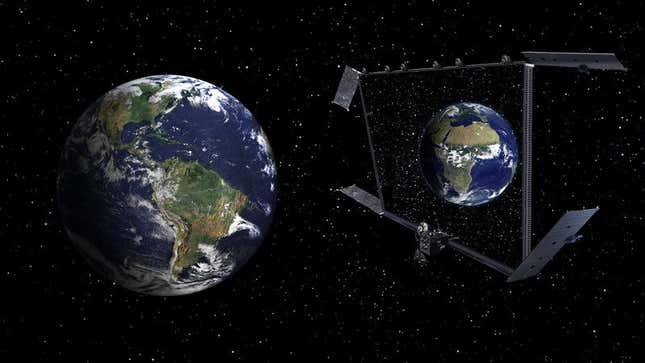
WASHINGTON—In what many are hailing as the most significant development in the history of space exploration, NASA scientists announced Thursday that a planet seemingly identical to Earth has been discovered by the agency’s Orbital Space Mirror.
According to NASA, the $2.9 billion aluminum glass mirror, which stretches over 180 feet wide and 147 feet tall, has already produced invaluable data suggesting that our solar system may contain a terrestrial planet of the exact same size, shape, and surface composition as Earth.
“This is a historic moment for humankind to confirm the existence of another planet that is almost indistinguishable from our own,” said mission leader Allen Brugel, who explained that after releasing the Orbital Mirror from a Delta IV heavy rocket at an operational altitude of 104,000 miles, the team received almost instantaneous images of an Earth-like planet approximately 208,000 miles away. “It is remarkable to find another celestial body where water is not only present but also covers two-thirds of the planet’s entire surface. What may be even more surprising is that it was discovered in a part of space that was previously thought to be completely empty.”
“It turns out that, in a universe that’s 93 billion light years wide, a planet perfectly suited for human life was right next to us in our own solar system,” Brugel added.
Built by NASA as part of a program created to identify planets in the galaxy capable of sustaining life, sources confirmed the orbiting plane mirror has provided scientists with continuous, real-time reflections of light rays since its launch in late October.
Scientists cited numerous key similarities between the newly discovered planet and our own, including the celestial body’s landmasses, oceans, wind patterns, cloud formations, apparent vegetation, and set of polar ice caps that strikingly resemble those found on Earth. Sources added that NASA’s preliminary surveys indicate that the recently detected body even completes one full rotation in approximately 24 hours and that, even more remarkably, its axial tilt is believed to also be exactly 23.5 degrees.
NASA scientists added that the new planet also possesses a single moon, though they noted that it appears to orbit and rotate in the complete opposite direction as Earth’s.
“Perhaps most fascinating is the significant amount of evidence indicating that sentient life may already be present on this new planet,” said Brugel, noting that portions of the planet’s surface are illuminated by artificial light at night, a phenomenon scientists say is most prevalent in the planet’s northern hemisphere. “We suspect they may be a significantly advanced society, as our mirror imaging system confirms that there are numerous sophisticated satellites circling the planet.”
“Beyond that, we can only begin to speculate what types of beings such a planet could produce,” he added.
According to sources, a recent unmanned mission to land on the body’s surface was aborted after discovering that life forms on the planet had launched a probe traveling at the same speed on a flight path identical to that of the NASA team. Internal NASA reports indicate that a potential head-on collision was narrowly avoided when both crafts simultaneously changed course at the last second.
“Overall, we’re pleased with our initial findings, and I believe the project has made excellent use of the lessons learned from the Helios Space Lens,” said Brugel, referring to an ill-fated mission in 1992 to provide advanced imaging of the sun using convex lens technology, an experiment which burned down NASA headquarters. “And after further studying deep space via the Orbital Mirror, we also determined that the universe appears to be perfectly symmetrical, a shocking finding that challenges all of our previously held theories.”
At press time, NASA had reportedly launched its Orbital Space Mirror 2 to the side of Earth opposite that of its original Orbital Space Mirror, leading scientists to conclude that there may actually be an infinite number of Earth-like planets stretching outward forever in a straight line through space.